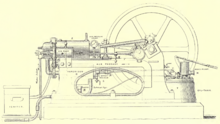William Dent Priestman
William Dent Priestman | |
|---|---|
| Born | 23 August 1847 Sutton-on-Hull, Kingston upon Hull, England |
| Died | 7 September 1936 (aged 89) |
| Education | Bootham School |
| Known for | internal combustion oil engine pioneer |
William Dent Priestman (23 August 1847 – 7 September 1936), born near Kingston upon Hull was a Quaker and engineering pioneer, inventor of the Priestman Oil Engine, and co-founder with his brother Samuel of the Priestman Brothers engineering company, manufacturers of cranes, winches and excavators. Priestman Brothers built the earliest recorded railway locomotive powered by an internal combustion engine.
Biography
William along with ten other offspring was the son of Leeds corn-miller (and latterly NER director) Samuel Priestman.[1]
He was educated at Bootham School in York,[2][3] and then apprenticed at the Humber Iron Works, later at the North Eastern Railway (NER) in Gateshead. In 1869 he then joined the engineering company owned by William Armstrong.[1][2] (William Armstrong & Company, later to become Armstrong Whitworth).
His father purchased the Holderness Foundry in Hull, and he began to do business independently; his brother joined him at the company, which later became Priestman Brothers.[1][4]
In the 1870s a licence to manufacture petrol engines (of a type designed by Eugène Etève, similar to Étienne Lenoir's engines) was obtained. The dangers and insurance costs of engines run on highly flammable petrol caused him to investigate the use of lamp oil in internal combustion engines. He obtained patents, including a patent for an oil vaporiser in 1885.[1] His investigations led him to develop one of the first reliable engines to work on a fuel heavier (more viscous and with a higher boiling point) than petrol,[5] known as the 'Priestman Oil Engine'.
In 1894 William and Samuel Priestman were given the John Scott Award for their engine.[6]
Having lost control of the Priestman company in 1895 following insolvency William spent the rest of his life helping others. He died in Hull in 1936.[1]
Legacy
The Priestman Oil Engine

The Priestman Oil Engine used a pressurised fuel tank, and fuel injection through a nozzle into a chamber heated by exhaust gasses in order to create a suitably combustible mixture in the cylinder. Incomplete vaporisation of the fuel resulted in some condensation on the walls of the cylinder; as a result the fuel both lubricated the cylinder as well as providing power. The engine also controlled the speed by connections between valves on the fuel inlets and a speed governor.[1] Ignition was by electric spark.[7]
The engine was manufactured from 1888 to 1904 with over 1,000 units produced,[5] largely for use on barges. One engine was trialled on the Hull and Barnsley Railway powering a shunting locomotive, this is the earliest known example of a locomotive powered by an internal combustion engine.[8]
One engine has been preserved as a stationary exhibit at the Streetlife Museum of Transport in Kingston upon Hull.[9] The engine design was recognised by the Engineering Heritage Hallmark Scheme awarded by the Institution of Mechanical Engineers in 2000 for its significance in British engineering history.[10][11]
Priestman Brothers
The company founded by William and Samuel Priestman produced diggers and dredgers as well as engines; in 1895 the company became bankrupt, and the brothers lost control of the firm. The company continued in the business of producing diggers and dredgers well into the latter half of the 20th century.
Other
In addition to his contribution to industry Priestman was also credited with inducing Sir Edward Fry to introduce an initial draft of the Bribery and Illicit Communications Act.[12]
See also
References
- ^ a b c d e f "Priestman, William Dent". Biographical Dictionary of the History of Technology
- ^ a b Priestman 2004, para.2.
- ^ Bootham School Register. York, England: Bootham Old Scholars Association (BOSA). 2011.
- ^ Priestman 2004, paras.2–3.
- ^ a b "Priestman oil engine built in 1895, on display at the Science Museum, c 1990". ingenious.org.uk. National Museum of Science and Industry.
- ^ "THE JOHN SCOTT AWARD PHILADELPHIA, PA, Award Recipients 1891–1900". garfield.library.upenn.edu. 1894.
- ^ Clerk, Dugald (1911). . In Chisholm, Hugh (ed.). Encyclopædia Britannica. Vol. 20 (11th ed.). Cambridge University Press. p. 41.
- ^ "Internal combustion locomotive engineers". steamindex.com. Priestman, William Dent. Retrieved 31 August 2010.
- ^ "Priestman Oil engine, Hull museums collections". hullcc.gov.uk. Hull City Council. Retrieved 31 August 2010.
- ^ "Engineering Heritage Hallmark Scheme" (PDF). imeche.org. Institution of Mechanical Engineers. Priestman’s Oil Engine (Yorkshire) – 29.03.00. Archived from the original (PDF) on 3 March 2016. Retrieved 31 August 2010.
- ^ "Recognising Engineering Excellence Past, Present and Future. Engineering Heritage Awards 25th Anniversary". imeche.org. Institution of Mechanical Engineers. Priestman Oil Engine, p.23.
- ^ "Prominent Quaker – Death of Mr. William D. Priestman", The Manchester Guardian, p. 13, 8 September 1936
Literature
- James Dent Priestman (1 February 1995). William Dent Priestman of Hull and the First Oil Engine. University of Hull, Centre for Continuing Education Development & Training, Industrial Studies Unit. ISBN 978-0-85958-039-7.
- Priestman, J. D.; Cummins, C. L. (1986). "William Dent Priestman, oil engine pioneer and inventor—his engine patents 1885–1901". Proceedings of the Institution of Mechanical Engineers, Part A: Power and Process Engineering. 200 (21 / A2): 69–80. doi:10.1243/PIME_PROC_1986_200_011_02. S2CID 108581704.
- "Priestman, William Dent". Biographical Dictionary of the History of Technology. Taylor and Francis. 27 June 2003. ISBN 0-203-02829-5. Archived from the original on 26 August 2010.
- Priestman, James Dent (2004). "Priestman, William Dent (1847–1936), engineer". Oxford Dictionary of National Biography (online ed.). Oxford University Press. doi:10.1093/ref:odnb/47180. (Subscription or UK public library membership required.)
External links
- John Perry (1900), The Steam engine and gas and oil engines, MacMillan and Co., pp. 458–464, 466
- Dugald Clerk (1904), The gas and oil engine, John Wiley & Sons, pp. 410–416, Figs. 188–191 (p.411, 412, 413, 417), also pp.464–467, and patent index (appendix)
